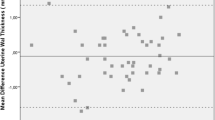Abstract
In 96 patients with congenital absence of the uterus and upper vagina, the Mayer-Rokitansky-KüsterHauser (MRKH) syndrome, it proved possible to distinguish between the typical and the atypical form using laparoscopy. The typical form was characterized by symmetrical nonfunctioning muscular buds (the Müllerian duct remnants) and normal fallopian tubes, and the atypical form by aplasia of one or both buds, one bud smaller than the contralateral one, with or without dysplasia of one or both fallopian tubes. The atypical form was found in 52 patients (54.2%). Radiographs of the spine showed that congenital spinal abnormalities, especially the Klippel-Feil (KF) syndrome, were seen in 14 of the 52 patients with the atypical form only. Renal agenesis or ectopia together with the MRKH and KF syndromes, known as the MURCS association (MU: Müllerian duct aplasia; R: renal agenesis/ectopia; CS: cervical somite dysplasia), was diagnosed in 10/52 patients in the atypical group. From our results we conclude that additional cervical spine films in patients with the MRKH syndrome are indicated only in the atypical form the syndrome. In those cases where the MRKH syndrome is associated with the KF syndrome, the MURCS association should be considered.
Similar content being viewed by others
References
Baird P, Lowry R (1974) Absent vagina and the Klippel-Feil anomaly. Am J Obstet Gynecol 118:290–291
Barach B, Falces E, Benzian S (1987) Magnetic resonance imaging for diagnosis and preoperative planning in agenesis of the distal vagina. Ann Plast Surg 19:192–194
Chawla S, Bery K, Indra K (1966) Abnormalities of the urinary tract and skeleton, associated with congenital absence of the vagina. Br Med J 1:1398–1400
Chervenak F, Stangel J, Nemec M, Amin H (1982) MayerRokitansky-Küster-Hauser syndrome. NY State J Med 82:23–27
Da Silva E (1982) Autosomal recessive Klippel-Feil syndrome. J Med Genet 219:130–134
Duncan P (1977) Embryologic pathogenesis of renal agenesiassociated with cervical vertebral anomalies (Klippel-Feil phenotype). Birth Defects 13:91–101
Duncan P, Shapiro L, Stangel J, Klein R, Addonizio J (1979) The MURCS-association: Muellerian duct aplasia, renal aplasia, and cervicothoracic somite dysplasia. J Pediatr 95:399–402
Fedele L, Dorta M, Brioschi D et al. (1990) Magnetic resonance imaging in Mayer-Rokitansky-Küster-Hauser syndrome. Obstet Gynecol 76:593–596
Ghirardini G, Segre A (1982) Vaginal agenesis (Mayer-Rokitansky-Küster-Hauser syndrome): recent etiopathogenetical and anatomical views. Clin Exp Obstet Gynecol 9:98–102
Gorlin R, Pindborg J, Cohen M (1976) Syndromes of the head and neck. McGraw-Hill, New York
Gray S, Romain C, Skandalakis J (1964) Congenital fusion of cervical vertebrae. Surg Gynecol Obstet 118:373–385
Griffin J, Edwards C, Madden J, Harrod M, Wilson J (1976) Congenital absence of the vagina, the Mayer-RokitanskyKüster-Hauser syndrome. Ann Int Med 85:224–236
Gunderson C, Greenspan R, Glaser G, Lubs H (1967) The Klippel-Feil syndrome: genetic and clinical reevaluation of cervical fusion. Medecin 46:491–512
Heidenreich W (1988) Genitale und extragenitale Fehlbildungen beim Mayer-Rokitansky-Küster-Hauser Syndrom. Dtsch Med Wochenschr 113:1092–1096
Muechler E (1975) Muellerian duct agenesis associated with renal and skeletal abnormalities. Am J Obstet Gynecol 121:567–568
Murphy A, Krall A, Rock J (1987) Bilateral functioning uterine anlagen with the Mayer-Rokitansky-Küster-Hauser syndrome. Int J Fertil 32:316–319
Nussbaum Blask A, Sanders R, Rock J (1991) Obstructed uterovaginal anomalies: demonstration with sonography. II. Teenagers. Radiology 179:84–88
Park I, Jones H (1971) A new syndrome in two unrelated females: Klippel-Feil deformity, conuctive deafness and absent vagina. Birth Defects 10:311–317
Ramsey J, Bliznak J (1971) Klippel-Feil syndrome with renal agenesis and other anomalies. Am J Roentgenol 113:460–463
Rosenberg HK, Sherman NH, Tarry WT, et al. (1986) Mayer-Rokitansky-Küster-Hauser syndrome: US aid to diagnosis. Radiology 161:815–819
Schmid-Tannwald I, Hauser G (1977) Deutung der “atypischen” Formen des Mayer-Rokitansky-Küster-Hauser syndrome. Geburtshilfe Frauenheilkd 37:386–392
Schmid-Tannwald I, Hauser G (1980) Das Mayer-RokitanskyKüster-Hauser Syndrom. Gynakol Prax 4:263–267
Shoul M, Ritvo M (1952) Clinical and roentgenologic manifestations of the Klippel-Feil syndrome (congenital fusion of the cervical vertebrae, brevicollis). Am J Roentgenol 68:269–285
Silverman F (1985) Caffey's pediatric X-ray diagnosis, 8th edn. Year Book Medical, Chaicago, p 298
Stark E, Borton T (1972) Hearing loss and the Klippel-Feil syndrome. Am J Dis Child 123:233–235
Strübbe E, Thijn C, Willemsen W, Lappoehn R (1987) Evaluation of radiographic abnormalities of the hand in patients with the Mayer-Rokitansky-Küster-Hauser syndrome. Skeletal Radiol 16:227–231
Strübbe EH, Willemsen WNP, Lemmens JAM, Thijn CJP, Rolland R (1992) Urinary tract anomalies and the atypical form of the Mayer-Rokitansky-Küster-Hauser syndrome, (in press)
Togashi K, Nishimura K, Itoh K, Fujisawa I, Nakamo Y et al. (1987) Vaginal agenesis: classification by MR imaging. Radiology 162:675–677
Turunen A, Unerus C (1967) Spinal changes in patients with congenital aplasia of the vagina. Acta Obstet Gynecol Scand 46:99–106
Willemsen W (1982) Neovagina-plastiek met peritoneum-transpositie. Thesis, Nijmegen
Willemsen W (1982) Combination of the Mayer-RokitanskyKüster-Hauser and Klippel-Feil syndrome. A case report and literature review. Eur J Obstet Gynecol Reprod Biol 13:229–235
Willemsen W, Dony J (1988) Een decennium ervaring met de behandeling van hypoen aplasia van de vagina met de neovaginaplastiek volgens Davydov en met de (niet-operatieve) methode van Frank. Ned Tijdschr Geneeskd 132:1199–1202
Winer-Muram H, Muram D (1984) The concurrence of facioauriculovertebral spectrum and the Rokitansky syndrome. Am J Obstet Gynecol 149:569–570
Author information
Authors and Affiliations
Rights and permissions
About this article
Cite this article
Strübbe, E.H., Lemmens, J.A.M., Thijn, C.J.P. et al. Spinal abnormalities and the atypical form of the Mayer-Rokitansky-Küster-Hauser syndrome. Skeletal Radiol. 21, 459–462 (1992). https://doi.org/10.1007/BF00190992
Issue Date:
DOI: https://doi.org/10.1007/BF00190992




